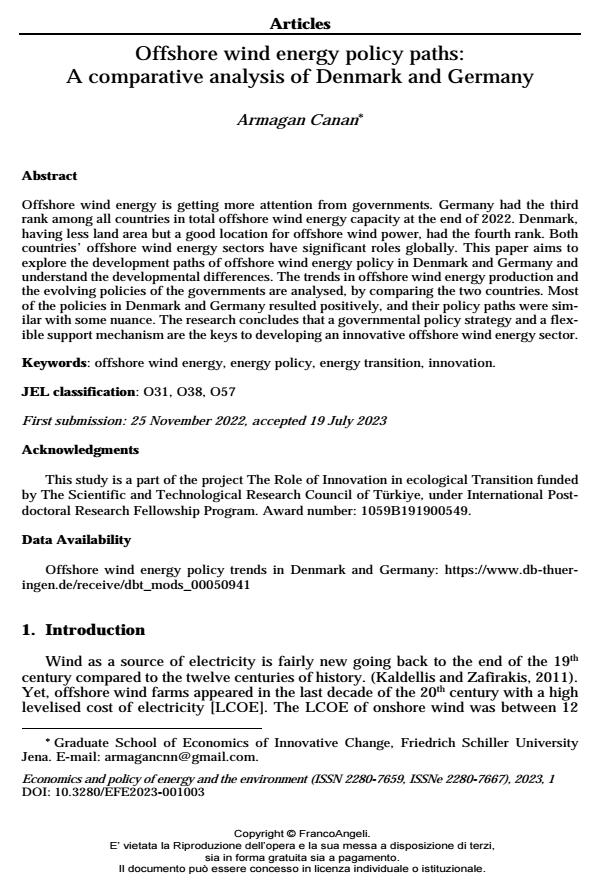Offshore wind energy policy paths: A comparative analysis of Denmark and Germany
Titolo Rivista ECONOMICS AND POLICY OF ENERGY AND THE ENVIRONMENT
Autori/Curatori Armagan Canan
Anno di pubblicazione 2023 Fascicolo 2023/1
Lingua Inglese Numero pagine 25 P. 35-59 Dimensione file 182 KB
DOI 10.3280/EFE2023-001003
Il DOI è il codice a barre della proprietà intellettuale: per saperne di più
clicca qui
Qui sotto puoi vedere in anteprima la prima pagina di questo articolo.
Se questo articolo ti interessa, lo puoi acquistare (e scaricare in formato pdf) seguendo le facili indicazioni per acquistare il download credit. Acquista Download Credits per scaricare questo Articolo in formato PDF

FrancoAngeli è membro della Publishers International Linking Association, Inc (PILA)associazione indipendente e non profit per facilitare (attraverso i servizi tecnologici implementati da CrossRef.org) l’accesso degli studiosi ai contenuti digitali nelle pubblicazioni professionali e scientifiche
Offshore wind energy is getting more attention from governments. Germany had the third rank among all countries in total offshore wind energy capacity at the end of 2022. Denmark, having less land area but a good location for offshore wind power, had the fourth rank. Both countries’ offshore wind energy sectors have significant roles globally. This paper aims to explore the development paths of offshore wind energy policy in Denmark and Germany and understand the developmental differences. The trends in offshore wind energy production and the evolving policies of the governments are analysed, by comparing the two countries. Most of the policies in Denmark and Germany resulted positively, and their policy paths were sim- ilar with some nuance. The research concludes that a governmental policy strategy and a flex- ible support mechanism are the keys to developing an innovative offshore wind energy sector.
Parole chiave:offshore wind energy, energy policy, energy transition, innovation.
Jel codes:O31, O38, O57
- Marine Spatial Planning for Offshore Wind Firms: A Comparison of Global Existing Policies and Data for Energy System Storage Yun-Sin Chen, Cheng-Yu Hu, Chun-Yi Li, Jia-Bin Lin, Yi-Che Shih, in Sustainability /2025 pp.5884
DOI: 10.3390/su17135884 - Offshore wind farms: An overview of licensing and legislation of North European countries Athina Danai Vardaka, Jacob G. Fantidis, in Wind Engineering 0309524X251406380/2025
DOI: 10.1177/0309524X251406380
Armagan Canan, Offshore wind energy policy paths: A comparative analysis of Denmark and Germany in "ECONOMICS AND POLICY OF ENERGY AND THE ENVIRONMENT" 1/2023, pp 35-59, DOI: 10.3280/EFE2023-001003